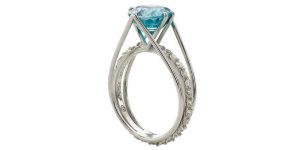Important coloured stones

Creating a setting for a major coloured stone is one instance when hand-making a piece may be the better option for all or part of a job. While diamonds are cut to enhance their brilliance, coloured stones are cut for depth of colour, which means you could be working with a thicker, uneven girdle or a deep pavilion. For low-end to mid-price coloured gems, your setter can usually work with a setting made using CAD; however, when the gemstone is on the pricey side, there is nothing better than a hand-built head with the wire drawn down. Since the piece isn’t cast, the wire needs just a light polish, which spares the stone the possibility of damage. When executed correctly, the metal almost sparkles. In addition, settings built this way are stronger because the wire has been cold-hardened.
So when is it a good idea to have machines do some of the heavy lifting? Werner Swoboda of Platinum Unlimited in Toronto says he usually asks his CAD operator to design the shank in 3D, create the wax mould using a printer or milling machine, and build hand-drawn wires for the head. The client can get the best of both worlds—
a perfectly symmetrical shank with a super clean, very fine setting. You can’t help but take a little bit more time admiring pieces fashioned this way.





